0 引言
煤炭是我国工业和社会的主要能源。瓦斯爆炸对煤炭安全开采构成重大威胁。由于煤矿采空区内部存在大量遗煤[1-2],经氧化后可形成煤自燃现象,当采空区涌出的瓦斯遇到煤自燃高温区域时可导致瓦斯爆炸事故的发生[3]。例如,吉煤集团通化矿业集团公司八宝煤业公司“3·29”瓦斯爆炸事故中,诱发瓦斯爆炸的火源就是煤自燃[4]。同时,采空区内部存在堆积的煤尘[5],煤自燃高温区域也可能诱发瓦斯/煤尘爆炸事故,使煤炭安全开采面临重大挑战[6]。开展煤自燃诱发瓦斯和煤尘燃烧与爆炸的研究对实现煤炭工业安全生产具有重大意义。
由于全面的矿井爆炸试验十分昂贵且耗时,国内外学者基于电火花诱发方式,使用实验室规模设备对瓦斯和煤尘爆炸、传播特性进行了研究。文献[7]最早开展了煤尘和气体爆炸研究,发现可燃粉尘与可燃气体混合物的爆炸比单一爆炸更为容易和剧烈。C. H. Medina等[8]利用1 m3 ISO爆炸容器试验装置对煤尘爆炸进行研究,发现高表面积煤尘由于煤焦的高孔隙率促进氧气扩散,使爆炸更为严重。Liu Qingming等[9]采用大型爆炸管对甲烷和煤尘爆炸特性进行研究,发现甲烷和煤尘对压力上升和火焰速度有较大影响。刘贞堂等[10]采用20 L球形爆炸装置研究了煤尘浓度、粒径、点火能量等对煤尘爆炸特征参数的影响。李晓亮等[11]采用20 L球形爆炸装置研究了煤尘浓度、粒径、点火能量对煤尘二次爆炸燃烧持续时间及残留气体的影响。
上述研究采用球形容器和管道容器,与煤矿采空区形状差别较大,不能准确模拟采空区环境。高温热源表面、电弧电火花均可能成为导致瓦斯和煤尘爆炸的诱发源。上述研究所采用的诱发源均为电火花。目前尚未有高温热源表面诱发甲烷/煤尘爆炸的相关研究[12]。此外,传统研究中,通过吹入的形式实现甲烷和煤尘混合,这与采空区内瓦斯涌出后流经煤自燃表面的过程差别较大,所得结论不能充分反映采空区内煤自燃诱发瓦斯/煤尘爆炸的特性。本文采用自主研制的40 L气体爆炸设备,设计高温热源表面点燃源模拟煤自燃区域,全面反映采空区煤自燃诱发甲烷/煤尘爆炸环境,研究煤自燃诱发甲烷/煤尘爆炸特性。
1 实验部分
1.1 实验设备
根据采空区内煤自燃诱发瓦斯爆炸过程研制出与其具有相似统一性的40 L气体爆炸设备。该设备由爆炸反应密闭容器、实验样品存储仓、温度测控装置、压力测控装置、光学视窗、防爆型抽真空泵、高温热源、电火花发生装置组成,如图1所示。
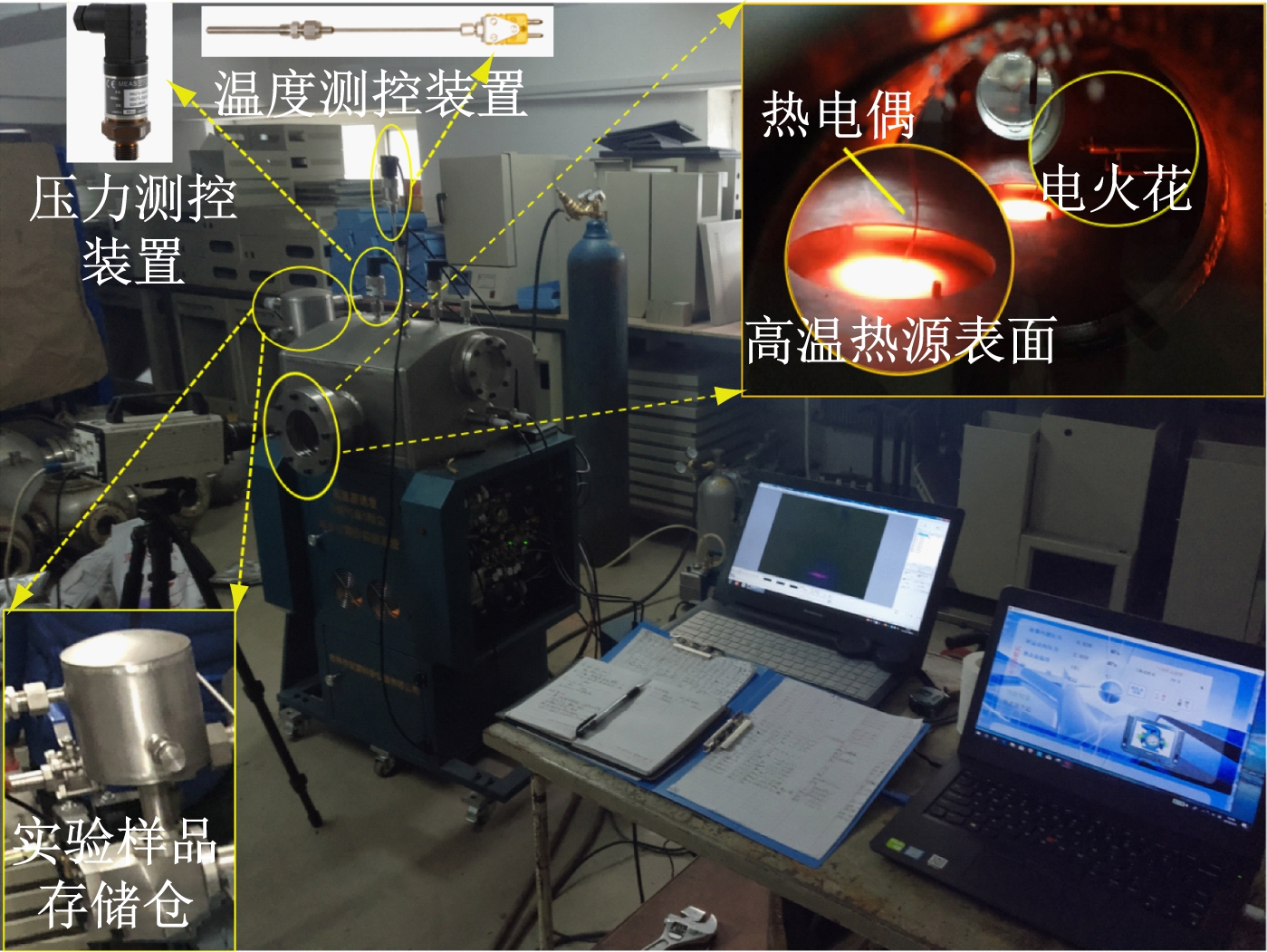
图1 气体爆炸实验设备
Fig.1 Gas explosion experimental equipment
实验采用的高温热源表面温度最高可达1 273 K,表面积为38.47 cm2。采用MEMRECAM GX-3高速摄像机拍摄爆炸反应过程。
1.2 实验材料
实验采用的煤样为辽宁抚顺矿业集团老虎台矿烟煤,煤样工业分析为挥发分33.71%,固定碳51%,灰分11.74%,水分4%。将煤样粉碎后,用筛分仪筛分后,使用Mastersizer3000测量煤尘的粒度分布特征,粒度(D90)为71.9 μm。通过ΣIGMA电镜扫描仪扫描煤尘放大1 600倍的电子扫描图像如图2所示。在实验开始前,将样品放入DZX-6090B真空干燥箱中干燥12 h,采用瓦斯中主要成分甲烷(体积分数为99.5%)开展研究。通过自动控制系统将压缩空气与甲烷混合并以分压法配比成不同浓度的甲烷/空气混合气体。
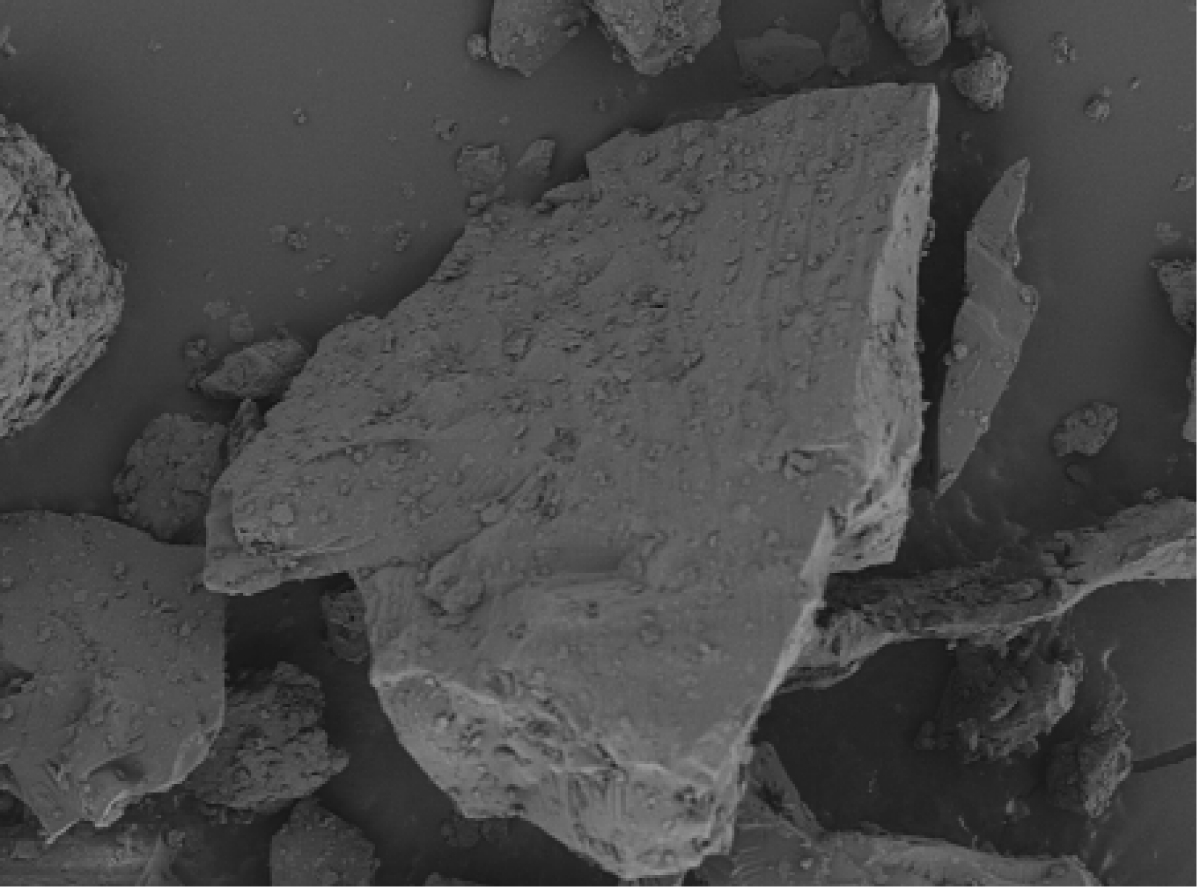
图2 煤尘电子扫描图像
Fig.2 Electronic scan image of coal dust
1.3 实验方法
通过抽真空泵在实验准备阶段实现真空环境。在上午8:00—11:00、下午3:00—6:00开展实验。实验环境:温度为20±3 ℃,湿度为30%±5%。诱发源选用高温热源表面和电火花隙。瓦斯体积分数范围为5.5%~13.5%,间隔体积分数为1%。煤尘浓度为300 g/m3。电火花能量为60 J,经过计算,高温热源表面温度为1 073 K[13]。开展煤尘爆炸实验时,事先将煤尘按照图3所示的方式铺设在高温热源表面,通过自动控制系统打开电磁阀,甲烷/空气冲入爆炸反应密闭容器内,将煤尘扬起,由高温热源表面或电火花引爆。开展煤尘点燃实验时,将不同浓度煤尘覆盖在高温热源表面,使高温热源表面温度升高,点燃煤尘。
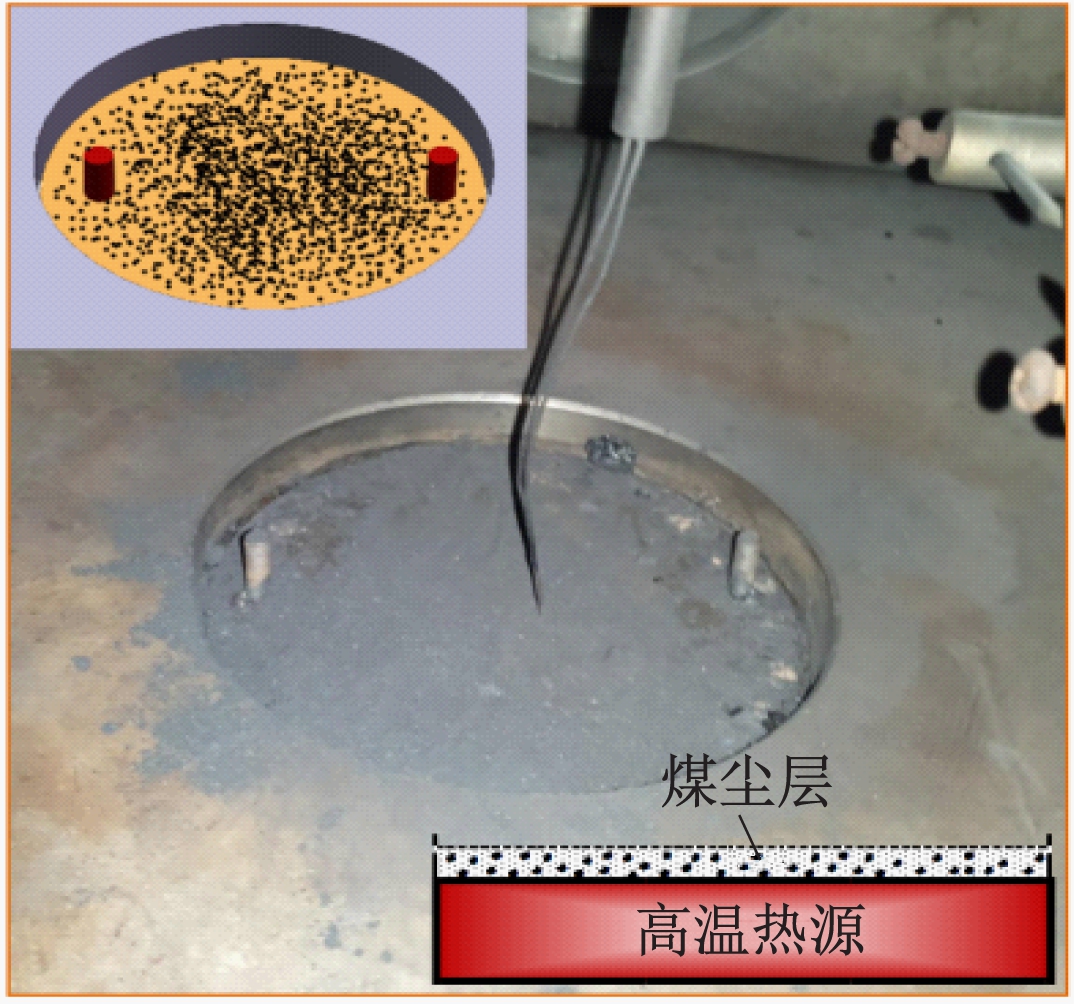
图3 煤尘铺设状态
Fig.3 Coal dust laying status
2 实验结果与分析
甲烷/煤尘的爆炸关键特征参数主要包括爆炸压力Pgd、压力上升速率(dP/dt)gd、爆炸温度Tgd[14-16],能够衡量爆炸的严重程度。
2.1 甲烷/煤尘爆炸关键特征参数随时间的变化规律
甲烷/空气(甲烷体积分数为8.5%)与甲烷/煤尘(甲烷体积分数为8.5%,煤尘浓度为300 g/m3)爆炸压力和爆炸温度随时间的变化规律如图4所示(其中Pg为甲烷/空气的爆炸压力,Tg为甲烷/空气的爆炸温度)。甲烷/煤尘(甲烷体积分数为9.5%、煤尘浓度为300 g/m3)的Pgd和Tgd随时间的变化规律如图5所示。

图4 甲烷/空气与甲烷/煤尘爆炸压力和爆炸温度随时间的变化规律
Fig.4 Change law of methane/air and methane/coal dust explosion pressure and explosion temperature with time
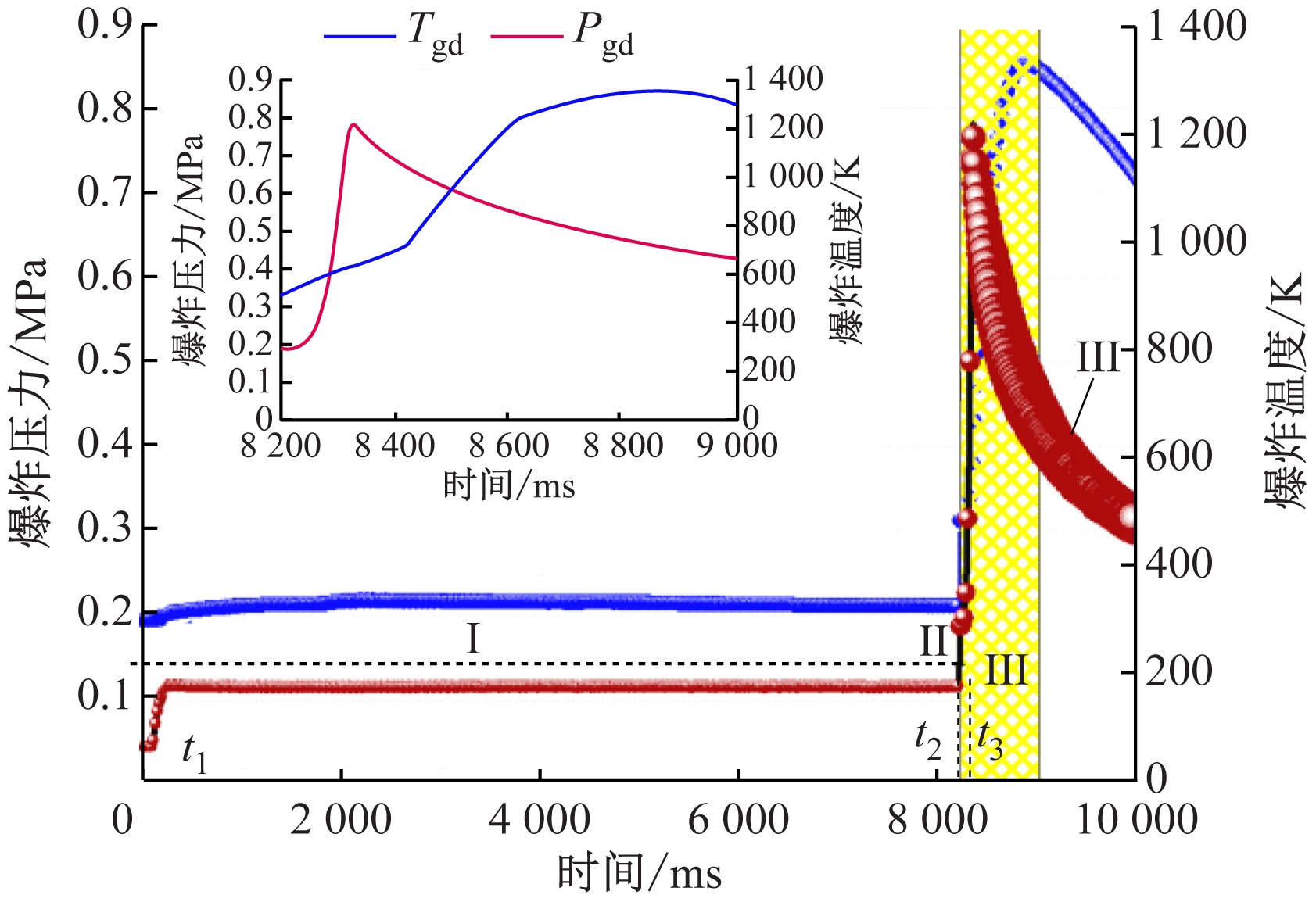
图5 甲烷/煤尘的Pgd和Tgd随时间的变化规律
Fig.5 Change law of Pgd and Tgd of methane/coal dust with time
根据图4和图5可知,甲烷/煤尘的Pgd随时间的变化规律与甲烷/空气的一致[17],均可划分为3个阶段,这与文献[18]通过电火花点火方式得到的规律一致。第Ⅰ阶段,t1时刻甲烷/空气冲入设备内,将煤尘扬起,形成甲烷/煤尘混合物;t2时刻甲烷/煤尘混合物被点燃,进入第Ⅱ阶段,即Pgd上升阶段;Pgd急速上升,在t3时刻达到峰值;随后爆炸结束,Pgd随时间逐渐下降,此时为第Ⅲ阶段。
为了更清晰地看到Pgd和Tgd随时间的变化,将Pgd和Tgd上升过程放大,即图5中的黄色部分。可看出Tgd的变化规律与Pgd一致,Tgd与Pgd上升时刻基本一致,表明Pgd的上升伴随着Tgd的升高。其他浓度组合的甲烷/煤尘的Pgd和Tgd随时间的变化规律基本一致。
2.2 甲烷/煤尘爆炸关键特征参数峰值随甲烷浓度的变化规律
在甲烷体积分数5.5%~13.5%下,将甲烷/煤尘(煤尘浓度为300 g/m3)最大爆炸压力Pgd-max、最大升压速率(dP/dt)gd-max与最大爆炸温度Tgd-max曲线,与甲烷/空气的最大爆炸压力Pg-max、最大升压速率(dP/dt)g-max、最大爆炸温度Tg-max进行对比,结果如图6所示,其中R2为拟合优度。
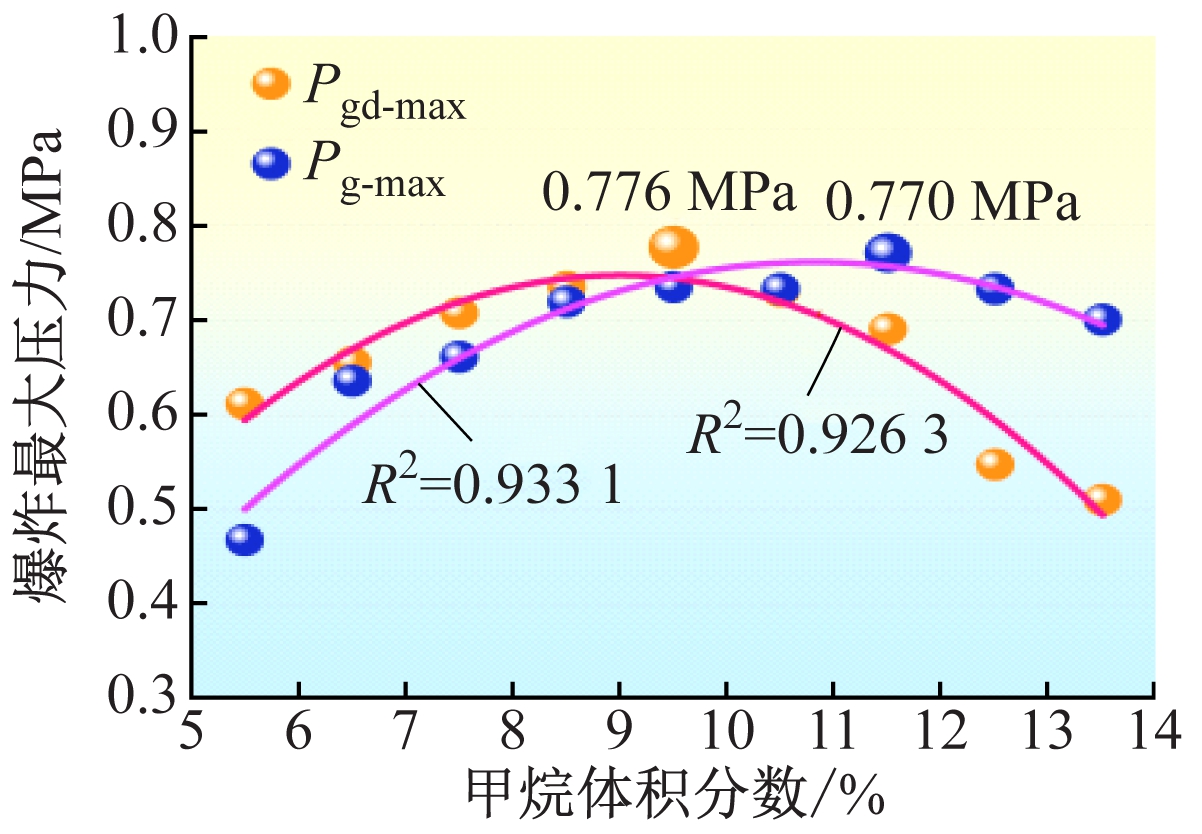
(a) 最大爆炸压力
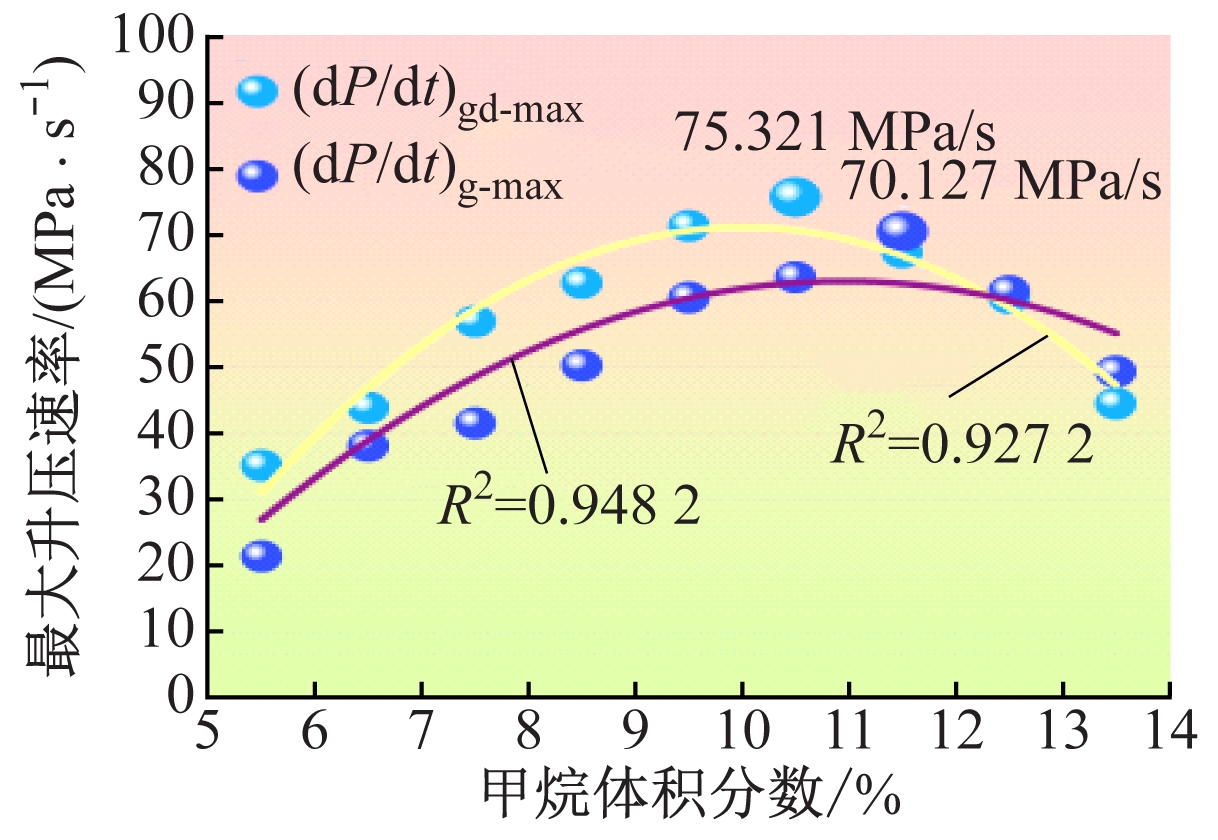
(b) 最大升压速率
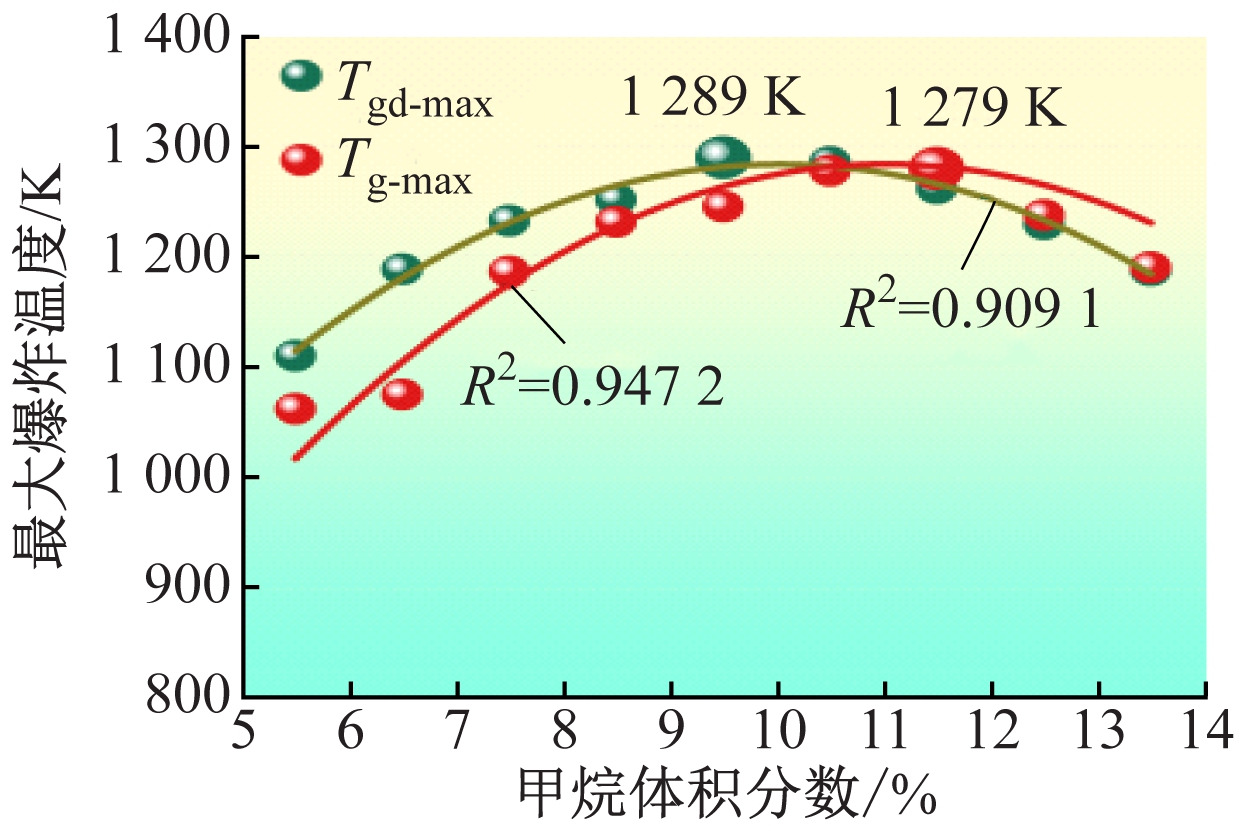
(c) 最大爆炸温度
图6 甲烷/煤尘和甲烷/空气爆炸关键特征参数随瓦斯浓度的变化规律
Fig.6 Change law of key characteristic parameters of methane/coal dust and methane/air explosion changes with the gas concentration
甲烷/煤尘的3个爆炸参数随甲烷浓度的变化规律基本一致,在较低甲烷浓度下均随甲烷浓度的增加而升高,在甲烷体积分数分别为9.5%,10.5%和9.5%时,Pgd,(dP/dt)gd和Tgd达到峰值,即为转折浓度,然后随甲烷浓度的升高而降低。
当甲烷浓度小于转折浓度时,由于煤尘的加入,Pgd-max,(dP/dt)gd-max和Tgd-max分别大于Pg-max,(dP/dt)g-max和Tg-max。这是因为甲烷/煤尘爆炸过程中,甲烷先于煤尘被引燃[19],释放出大量的热能,促进了煤尘颗粒的热解,从而增强了煤尘的爆炸强度,使得煤尘爆炸特性增强。当甲烷浓度大于转折浓度时,甲烷比例增大,氧气比例减小,煤尘内的挥发性物质和甲烷竞争获取氧气的影响加剧,此时煤尘起到抑制作用,Pgd-max,(dP/dt)gd-max和Tgd-max分别小于Pg-max,(dP/dt)g-max和Tg-max。
高温热源诱发方式下,Pg-max,(dP/dt)g-max,Tg-max转折体积分数均为11.5%,高于电火花的9.5%[17],由于煤尘的加入,其转折体积分数分别降为9.5%、10.5%和9.5%。这是由于高温热源诱发方式下,甲烷/空气在11.5%时反应充分[17],其氧气含量足以使爆炸关键特征参数达到峰值。当加入300 g/m3煤尘后,一部分氧气参与煤尘的氧化,发生甲烷/煤尘充分燃烧与爆炸则需要更多的氧气,导致甲烷浓度降低。此外,由于煤尘的参与,Pg-max,(dP/dt)g-max和Tg-max分别增加了0.8%,6.9%和0.8%。
对各浓度下甲烷/煤尘的Pgd-max,(dP/dt)gd-max和Tgd-max进行拟合。由图6可知,拟合优度R2均较未加入煤尘时降低,说明由于煤尘的参与,Pgd-max,(dP/dt)gd-max和Tgd-max的规律性下降。
可看出煤尘的添加对Pg-max,(dP/dt)g-max,Tg-max存在明显的影响,体现在转折浓度下降,关键特征参数峰值升高,且规律性下降,煤尘与瓦斯共存增加了对煤矿开采的威胁。
2.3 点火方式对甲烷/煤尘爆炸的影响
不同点火方式下甲烷/煤尘(甲烷体积分数为8.5%、煤尘浓度为300 g/m3)Tgd随时间的变化规律如图7所示。
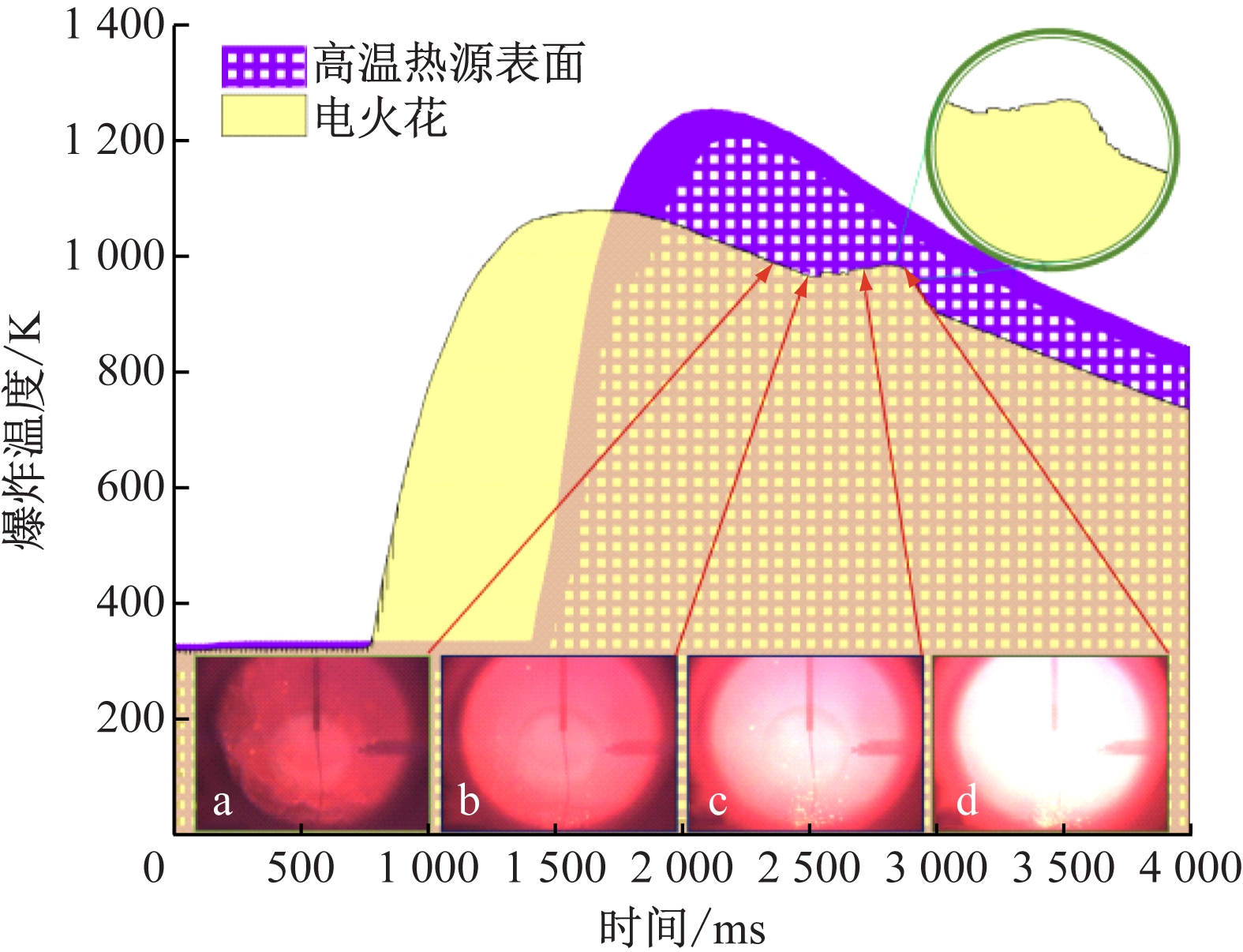
图7 不同点火方式下瓦斯/煤尘Tgd随时间的变化规律
Fig.7 Change law of gas/coal dust Tgd under different ignition modes with time
可看出在电火花点火方式下,Tgd 在下降期出现再次升高的现象。这是因为甲烷/空气冲入爆炸反应密闭容器后,吹起一部分煤尘,煤尘与甲烷混合燃烧,温度迅速上升,出现第1个峰值。由于煤尘的存在,导致电火花引爆的球形火焰出现明显的湍流(a)。当球形火焰传播到容器下部时,火焰对下部煤尘进行冲击,导致煤尘迅速燃烧(c,d),温度再次上升,在温度下降期再次出现温度升高的现象。
在高温热源表面点火方式下,甲烷/煤尘的Tgd只出现了1个峰值,其变化规律与未加入煤尘前一致。这是因为在高温热源表面诱发条件下,煤尘铺设在高温热源表面,其点火区域面积较电火花方式更大,导致爆炸时煤尘与瓦斯/空气燃烧充分,促使温度直接升高。到反应后期,煤尘已经随甲烷燃烧结束。该过程如图8所示(爆炸压力开始升高的时刻记做0 ms)。
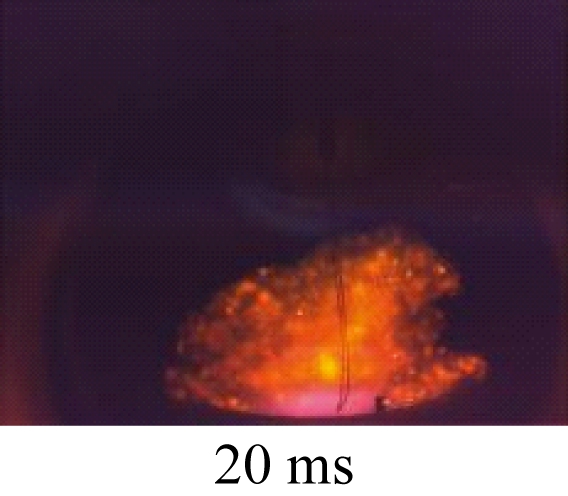
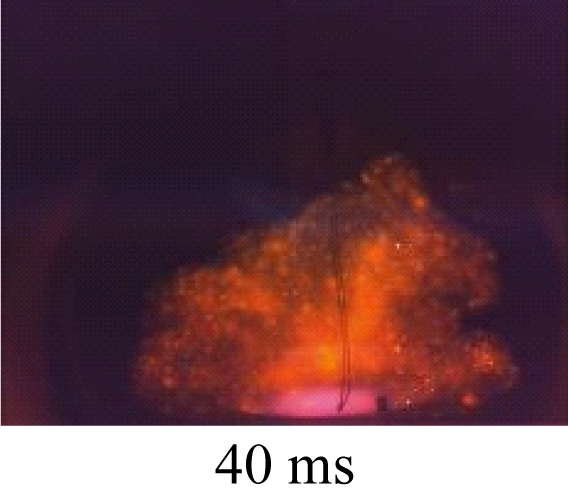
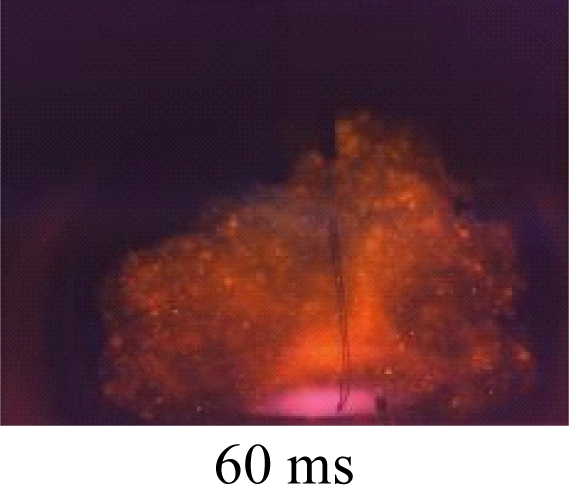
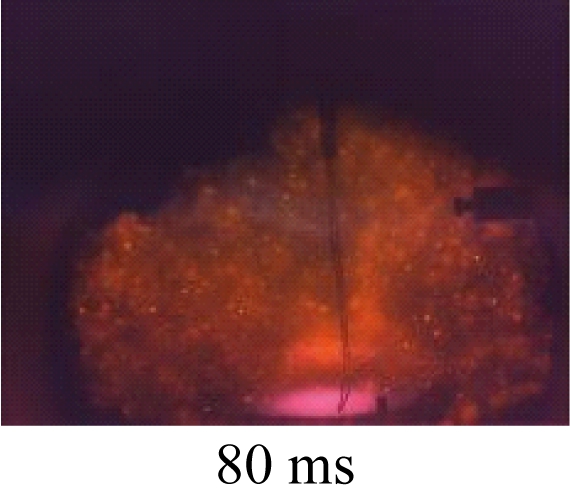
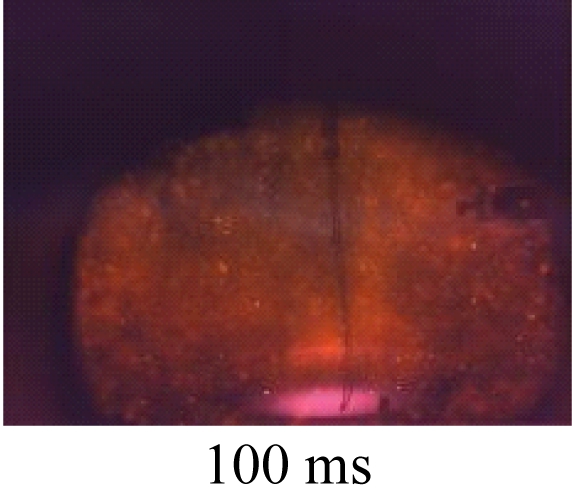
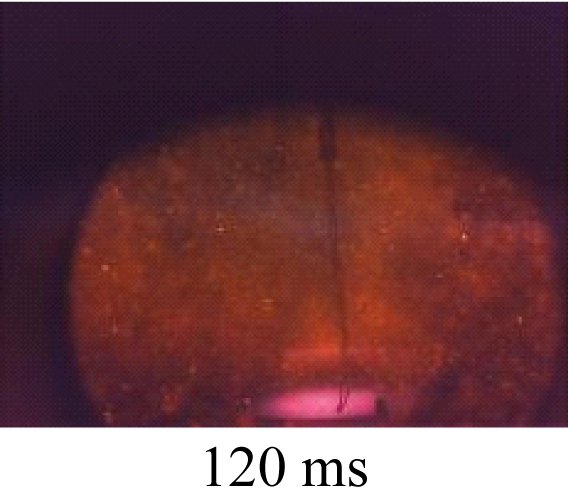
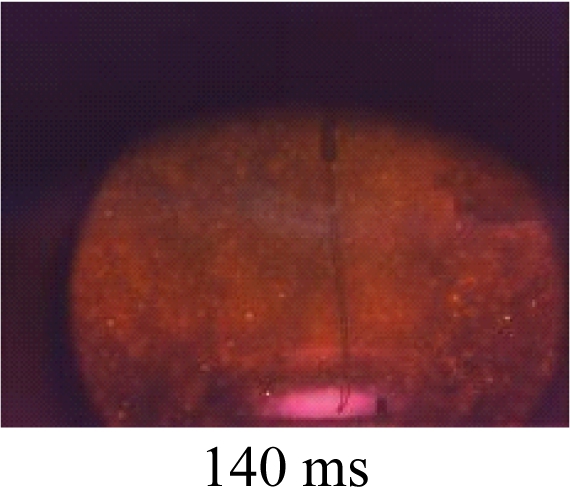
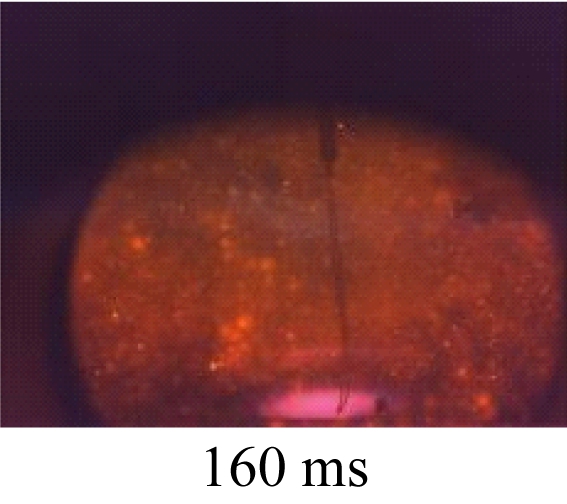
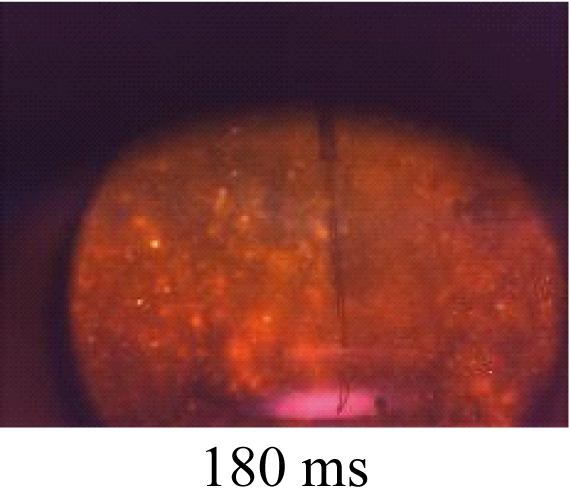
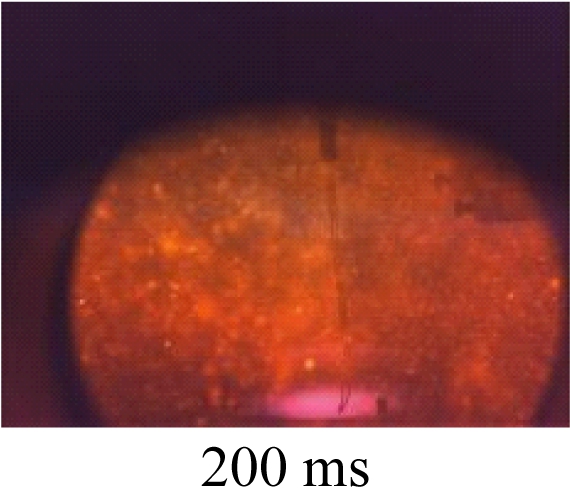
图8 甲烷/煤尘混合物爆炸火焰发展过程
Fig.8 The explosive flame development process of the methane/ coal dust mixture
2.4 煤尘的点燃温度
以往主要采用冲入煤尘、电火花点燃方式对煤尘爆炸进行研究。而采空区内煤自燃高温表面的煤尘以堆放的形式存在,与采空区内煤尘的存在形式不符,其结果很难反应采空区内煤自燃诱发瓦斯/煤尘爆炸过程。由于甲烷/煤尘冲入设备内发生爆炸前,铺设在高温热源表面的煤尘已发生热分解,其氧化分解出的可燃气体挥发分导致甲烷/空气爆炸关键特征参数升高。为深入开展煤自燃诱发瓦斯/煤尘爆炸研究,通过1 073 K高温热源测试铺设在其表面的煤尘点燃温度,以了解在甲烷/空气冲入设备前煤尘的热解状态。K. N. Palmer等[20]通过金属热表面对煤尘的点燃温度进行实验研究,发现随着煤尘厚度的增加,煤尘被高温表面点燃的温度降低。
煤尘点燃温度预测函数如图9所示。K. N. Palmer等通过实验列出6个数据点(蓝色球形符号),得出其符合线性规律的结论,式(1)为其线性拟合函数。对6个数据重新处理,得到红色拟合曲线,式(2)为修正后的拟合函数。修正拟合函数R2较线性拟合提高了20.05%。
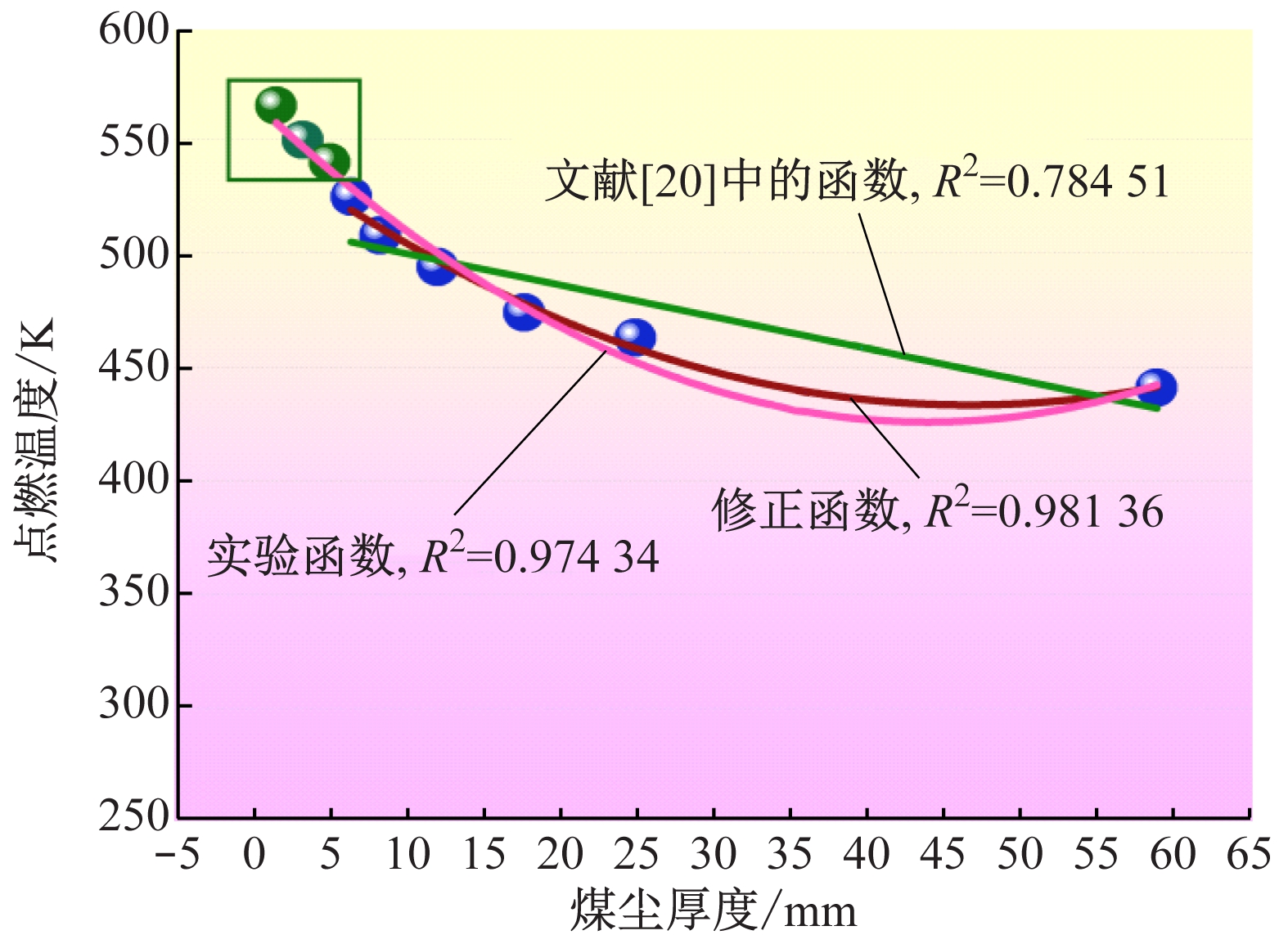
图9 煤尘点燃温度预测函数
Fig.9 Coal dust ignition temperature prediction function
T=-1.401 93l+514.284 87,R2=0.784 51
(1)
T=-4.997 69l+0.053 6l2+549.861 13,
R2=0.981 36
(2)
式中:T为煤尘的点燃温度,K;l为煤尘的铺设厚度,mm。
通过高温热源表面,对100,200,300 g/m3煤尘的点燃温度进行测试,本实验测试得到的数据如图9方形区域所示。3个浓度的煤尘铺设在高温热源表面,厚度分别为1.7,3.4 ,5.2 mm,对应的点燃温度分别为565,550,545 K。与修正后的拟合函数(式(2))得到的数值误差分别为4.1%,3.0%,3.6%,误差较小,验证了修正拟合函数的正确性。
将实验数据与文献[20]中的测试数据相结合,得到新的拟合函数(式(3)),其R2达到0.974 34。可用于高温热源表面铺设煤尘点燃温度的预测。
T=-6.491 03l+0.073 87l2+568.491 3,
R2=0.974 34
(3)
3 结论
(1) 通过高温热源表面点火方式得到的甲烷/煤尘爆炸过程与甲烷/空气爆炸过程一致,均可划分为3个阶段。
(2) 甲烷/煤尘的3个爆炸参数随甲烷浓度的变化规律一致,即先随着甲烷浓度的增加而升高,达到峰值后随甲烷浓度的增加而降低;当甲烷浓度小于转折浓度时,Pgd-max,(dP/dt)gd-max和Tgd-max分别大于Pg-max,(dP/dt)g-max和Tg-max;当甲烷浓度大于转折浓度时,Pgd-max,(dP/dt)gd-max和Tgd-max分别小于Pg-max,(dP/dt)g-max和Tg-max;由于煤尘的加入,甲烷/空气3个爆炸参数的转折体积分数由11.5%分别降至9.5%,10.5%和9.5%,峰值分别增加了0.8%、6.9%和0.8%,且规律性下降。
(3) 由于点火方式不同,Tgd的变化规律不同:电火花引爆甲烷/煤尘后Tgd在下降阶段(Ⅲ阶段)再次出现升高的现象;高温热源表面引爆甲烷/煤尘后Tgd变化规律与未加入煤尘前保持一致。
(4) 对煤尘点燃温度预测函数进行了修正,修正后的R2提高了20.05%;结合实验数据得到了煤尘在高温热源表面点火方式下的点燃温度预测函数。
[1] TANG Zongqing,YANG Shengqiang,WU Guangyu.Occurrence mechanism and risk assessment of dynamic of coal and rock disasters in the low-temperature oxidation process of a coal-bed methane reservoir[J].Energy & Fuels,2017,31(4):3602-3609.
[2] MENG Ya,LI Zhiping.Experimental study on diffusion property of methane gas in coal and its influencing factors[J].Fuel,2016,185(1):219-228.
[3] 高洋.煤矿开采引起的采空区瓦斯与煤自燃共生灾害研究[D].北京:中国矿业大学(北京),2014.
GAO Yang.Study on symbiotic disasters of gas and spontaneous combustion of coal in the gob area by mining[D].Beijing:China University of Minging and Technology(Beijing),2014
[4] 王海东.浅析我国煤矿安全事故引发原因[J]. 化工中间体, 2015,11(12):33-34.
WANG Haidong.Analysis of the causes of coal mine safety accidents in China[J].Chemical Intermediates,2015,11(12):33-34.
[5] 李润之.瓦斯爆炸诱导沉积煤尘爆炸的研究[D].北京:煤炭科学研究总院, 2007.
LI Runzhi.Study of deposited coal dust explosion due to gas explosion[D].Beijing:China Coal Research Institute,2007.
[6] CAO Weiguo,CAO Wei,PENG Yuhuai,et al.Experimental study on the combustion sensitivity parameters and pre-combusted changes in functional groups of lignite coal dust[J].Powder Technology,2015, 283:512-518.
[7] ROYCHOWDHUR NARAYAN S.Coal dust explosions and their prevention[M].University of Missouri:School of Mines and Metallrugy,1960.
[8] MEDINA C H,MAEEOITIR B,SATTAR H,et al. Comparison of the explosion characteristics and flame speeds of pulverised coals and biomass in the ISO standard 1 m3 dust explosion equipment[J].Fuel,2015,151(1):91-101.
[9] LIU Qingming,HU Yongli,BAI Chunhua,et al.Methane/coal dust/air explosions and their suppression by solid particle suppressing agents in a large-scale experimental tube[J].Journal of Loss Prevention in the Process Industries,2013,26(2):310-316.
[10] 刘贞堂,郭汝林,喜润泽.煤尘爆炸特征参数影响因素研究[J].工矿自动化, 2014, 40(8):30-33.
LIU Zhentang,GUO Rulin,XI Runze.Research of influence factors on characteristic parameters of coal dust explosion[J].Industry and Mine Automation,2014,40(8):30-33.
[11] 李晓亮,鄢利,刘贞堂,等.煤尘二次爆炸燃烧持续时间及残留气体分析[J].工矿自动化,2018, 44(11):62-68.
LI Xiaoliang,YAN Li,LIU Zhentang,et al. Analysis of combustion duration and residual gas in secondary explosion of coal dust[J].Industry and Mine Automation,2018,44(11):62-68.
[12] KUNDU S K,ZANGANEH J,ESCHEBACH D,et al.Explosion characteristics of methane-air mixtures in a spherical vessel connected with a duct[J].Process Safety & Environmental Protection,2017,111:85-93.
[13] 王海燕,张雷,吕佳溪.点火方式对甲烷爆炸生成气体产物的影响研究[J].煤矿安全,2020,51(5):16-20.
WANG Haiyan,ZHANG Lei,LYU Jiaxi.Study on gas product of gas explosion under different egnition modes[J].Safety in Coal Mines,2020,51 (5): 16-20.
[14] ASTM E 1491-06 Standard test method for minimum autoignition temperature of dust clouds[S].
[15] ASTM E 1515-14 Standard test method for minimum explosible concentration of combustible dusts[S].
[16] ASTM E 1226-05 Standard test method for pressure and rate of pressure rise for combustible dusts[S].
[17] 王海燕,张雷,郭增乐.基于自研设备高温源诱发甲烷爆炸特性研究[J].工矿自动化, 2019,45(5):11-15.
WANG Haiyan,ZHANG Lei,GUO Zengle.Research on characteristic of methane explosion induced by high-temperature source based on self-developed equipment[J].Industry and Mine Automation,2019,45(5):11-15.
[18] YU Jianliang,YAN Xingqing.Reliability of dust explosion venting standards under elevated static activation overpressures[J].Journal of Northeastern University,2015,36(9):1316-1320.
[19] LI Haitao,DENG Jun,CHEN Xiaokun,et al.Qualitative and quantitative characterisation for explosion severity and gaseous-solid residues during methane-coal particle hybrid explosions:an approach to estimating the safety degree for underground coal mines-sciencedirect[J].Process Safety and Environmental Protection,2020,141:150-166.
[20] PALMER K N, TONKIN P S.The ignition of dust layers on a hot surface[J].Combustion & Flame,1957,1(1):14-18.
